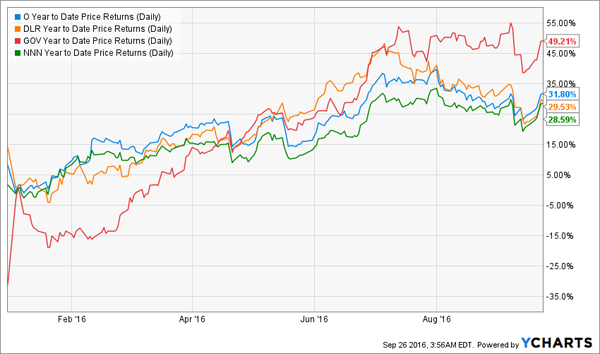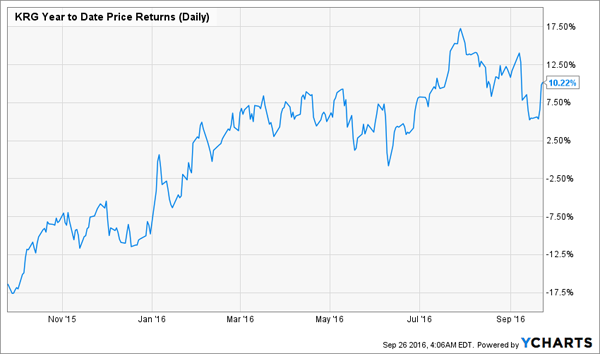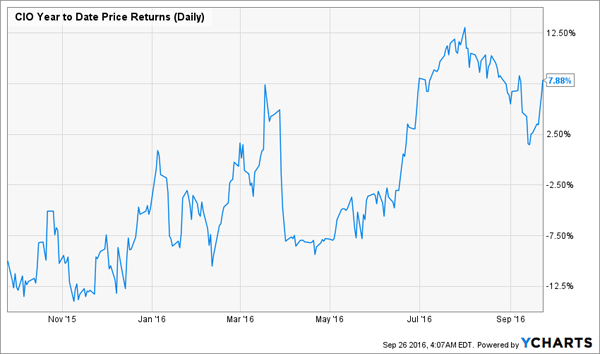Is it too late to buy REITs (real estate investment trusts)? It depends. Some lesser-known issues are still great bargains, while others have rallied to nosebleed valuations.
I’ll highlight three specific buys – and tell you what you should sell – in a moment. First, let me show you why investors are hesitant about REITs:
How Hot is Too Hot?

These are the price-only returns (not including dividends) of four REITs. Three of them are quite popular, while one—Government Properties Trust (GOV)—is extremely controversial. Note the controversial one is up 49% year-to-date!
That’s amazing, but the usual stability of popular dividend payers like Realty Income Corporation (O) and National Retail Properties (NNN) means they should not be up 30% in less than a year. Yet here we are with big-time gains as yield hungry investors seek to get into this asset class before it’s too late.
Consider Digital Realty Trust (DLR), a popular tech-based REIT whose high yield once reflected the perceived dangers of its underlying industry. No more—DLR’s dividend (3.6%) has been bid down towards reliable O’s (3.5%). In a low-rate world, investors are willing to look ignore risk factors.
There’s another reason why REITs are so hot this year—they’re becoming their own asset class and will be indexed accordingly. This means passive funds will need to buy them in big chunks very soon – which is why some front runners astutely bought the blue chip names in the space already.
Which brings us to today. With the huge gains in these stocks, there’s been a real fear of buying REITs at the “top” of the market. If you fear missing out on the great REIT bull run, I have news for you: It isn’t too late if you look past the expensive blue chips.
Here are three solid, reliable and underappreciated REITs who aren’t yet overpriced.
Kimco Realty (KIM) is a retail property-focused REIT whose one year price return of 13% is the highest of the lot.
Kimco’s Retail Play

The stock has benefitted a bit from the hunger for REITs, but that doesn’t mean it’s overpriced. Right now the REIT pays a 3.4% yield and its TTM price to funds from operations (FFO – the key earnings measure for REITs) ratio of 16.7 is at the lower end of the market. The company has done a great job of growing its income by expanding operations and keeping a stable of high quality tenants in its premium retail spaces.
Similarly, there’s good reason to buy Kite Realty Group Trust (KRG), a much smaller REIT that also invests in retail spaces. KRG owns commercial property across New England, Florida and the Southwest.
Modest Gains for KRG

This company is up only 10% year-to-date, or about a third of O or NNN’s price returns. Yet it’s cheap. The firm’s price-to-FFO ratio is 13.9—much lower than KIM’s, yet its 3.9% dividend is a bit juicier. Because it’s smaller, investors are pricing in more risk—but with dividends more than fully covered by FFO and a footprint expansion into premium spaces, there’s no reason to fear for KRG’s future.
One more for our REIT portfolio—a riskier choice. Let’s add City Office Realty (CIO) to the mix and enjoy its 7.2% dividend.
CIO (Finally) Rallies

With a 7.9% year-to-date price return, CIO is the laggard of the lot, although almost 8% in a year is a big victory for almost any stock in a normal year. Of course, this is no normal year for REITs, which makes CIO an even better buy at the moment.
Why isn’t it up more? One reason: commercial real estate. CIO focuses on renting office space, and commercial real estate has jumped in value over the last couple years. There is a fear that office space is overvalued, and that’s why this company’s dividend is so high.
But we aren’t worried. With a run rate of $1.21 in FFO for 2016, the stock is priced at 11.5-times FFO, making it absurdly cheap in the REIT universe (many REITs are now priced at 25 or higher according to this metric). In other words, if you bought the entire firm today, you’d receive your money back in rental checks within 12 years.
Again, the stock’s small market cap ($321 million) and office real estate focus are the reasons behind this undervaluation. Simply put, CIO is too small to get noticed by most, making it a deep value stock paying a tremendously high dividend.
With these three REITs, we have a portfolio yielding 4.8% and stocks with potential for tremendous dividend growth in the future. We’re doing this by looking for the REITs that are deeply undervalued and overlooked by a market obsessed with REITs. This is stealth investing at its best.
In the past, all REITs were a great stealth play because the market tended to ignore them. Now profitable investing in the sector is harder, but not impossible. In fact, some REITs offer recession-proof returns, high yields, and dividend growth. CIO isn’t the only one yielding 7%—in fact, some of my favorites still pay over 8%!
That’s why I use recession proof REITs as a cornerstone of my No Withdrawal Portfolio. You see, I want to make a portfolio that yields 8% full of stocks I will never have to sell, no matter what happens in the market. Doing this, I can avoid the worst thing that can happen to a retiree: having to withdraw from the portfolio during a down year.
I love the idea of a No Withdrawal Portfolio, which is why I’m collecting not just REITs but other funds and stocks that retirees can own and never have to worry about a market downturn again. Click here and I’ll show you what is in the portfolio, and how it can provide such amazing returns no matter what happens to the economy.
